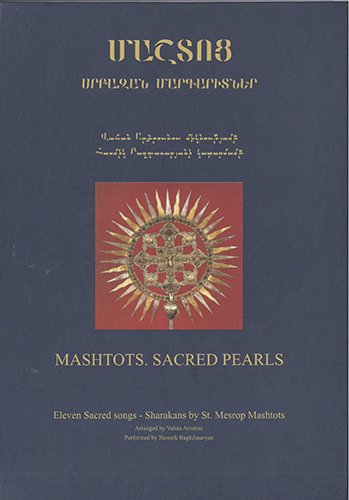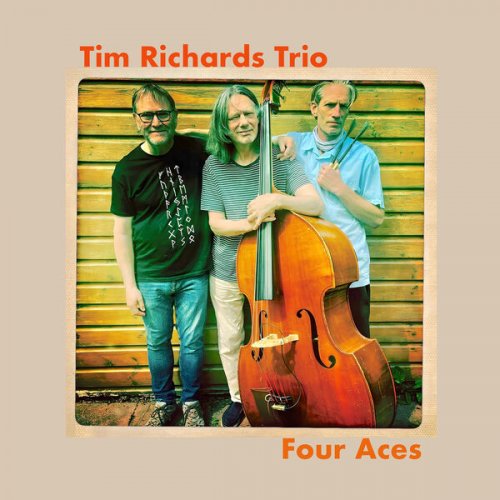Hasmik Baghdasaryan, Vahan Artsruni - Mashtots: Sacred Pearls (2011)

Artist: Hasmik Baghdasaryan, Vahan Artsruni
Title: Mashtots: Sacred Pearls
Year Of Release: 2011
Label: Naregatsi Art Institute
Genre: Classical, Vocal
Quality: FLAC (image+.cue,log,scans)
Total Time: 40:20
Total Size: 146 Mb
WebSite: Album Preview
Tracklist: Title: Mashtots: Sacred Pearls
Year Of Release: 2011
Label: Naregatsi Art Institute
Genre: Classical, Vocal
Quality: FLAC (image+.cue,log,scans)
Total Time: 40:20
Total Size: 146 Mb
WebSite: Album Preview
With Instrumental (arr. Vahan Artsruni)
01. Voxormea (Ankanim) (1:48)
02. Nexutyan Imum (1:48)
03. Ter Vor I Mej Lerinn (1:16)
04. Bazum En Qo Gtutiunqd (2:01)
05. Voxormea Indz Astuats (2:23)
06. Vtangim I Bazmutene Mexats Imots (1:35)
07. Mexay Qez Ter (2:25)
08. Tsov Kentsaxoys (1:20)
09. Voxormea (1:33)
10. Zxjman Imoy Zartasus (2:47)
11. Hamenayn Jam (1:32)
A capella
12. Voxormea (Ankanim) (1:31)
13. Nexutyan Imum (1:47)
14. Ter Vor I Mej Lerinn (1:16)
15. Bazum En Qo Gtutiunqd (2:00)
16. Voxormea Indz Astuats (2:20)
17. Vtangim I Bazmutene Mexats Imots (1:36)
18. Mexay Qez Ter (2:24)
19. Tsov Kentsaxoys (1:18)
20. Voxormea (1:33)
21. Zxjman Imoy Zartasus (2:42)
22. Hamenayn Jam (1:25)
Performers:
Hasmik Baghdasaryan, soprano
Vahan Artsruni
On October 8, 2011, the presentation of the unique 'Mashtots: Sacred Pearls' CD album marked the release of the 35th publication produced by Naregatsi Art Institute. Arranged by Vahan Artsruni and performed by soprano Hasmik Baghdasaryan, the album features both monophonic and sampler-arranged polyphonic recordings of sharakans (sacred songs) by Mesrop Mashtots. A rare artefact, the CD is the first ever published production in Armenia assembling all the 11 sharakans we definitely know belong to St. Mesrop Mashtots.
St. Mesrop Mashtots is commonly reputed for his invention of the Armenian Alphabet. Few know, however, that he also stands in the roots of the origination and formation of the Armenian melos, since back in the fifth century he pioneered the creation of around 130 prose poetry pieces which were then transformed into music in a collaboration with Catholicos St. Sahak Partev and incorporated into the Hymnal of the Armenian Church. This valuable musical heritage created by the Mashtots-Partev tandem is lost completely, with the exception of 11 of them which comprise the repertoire of the featured CD album.
In terms of its philosophy and methodology, this unique production leans rather towards the post-modernist paradigm of composing music. Being an instance of a creative engagement with the past, the album views the centuries-old musical pieces as documented raw material to play and experiment with without however detaching them from their historicity. The engagement with the past, in this case, takes the form of polyphonizing the fifth century monophonic church hymns. As such, the CD is not the first attempt of transforming Armenian monophonic church music into polyphonic compositions. Already back at the end of the 19th century composer Makar Yekmalian has pioneered these attempts. But this CD is the first ever attempt in the history of Armenian music where polyphonic arrangements are made through electronic media, by means of sample-based computer technologies. The chamber and woodwind orchestral and the choral performances in the album are computer generated and electronically produced.
The project is unique and postmodernist also in terms of its practice of shifting and deconstructing the accepted procedures and sequences of composing, performing and recording music. Usually works are recorded or performed only after their scores have been finalized and put to paper. In this case, the sequence is upset. The songs were first recorded in their archaic archetypical forms performed by soprano Hasmik Baghdasaryan, and only thereafter did Vahan Artsruni commenced on their arrangements into polyphonic compositions. The CD features both the versions: 11 monophonic archaic performances and 11 polyphonic rearrangements of the same pieces (22 tracks altogether).
St. Mesrop Mashtots is commonly reputed for his invention of the Armenian Alphabet. Few know, however, that he also stands in the roots of the origination and formation of the Armenian melos, since back in the fifth century he pioneered the creation of around 130 prose poetry pieces which were then transformed into music in a collaboration with Catholicos St. Sahak Partev and incorporated into the Hymnal of the Armenian Church. This valuable musical heritage created by the Mashtots-Partev tandem is lost completely, with the exception of 11 of them which comprise the repertoire of the featured CD album.
In terms of its philosophy and methodology, this unique production leans rather towards the post-modernist paradigm of composing music. Being an instance of a creative engagement with the past, the album views the centuries-old musical pieces as documented raw material to play and experiment with without however detaching them from their historicity. The engagement with the past, in this case, takes the form of polyphonizing the fifth century monophonic church hymns. As such, the CD is not the first attempt of transforming Armenian monophonic church music into polyphonic compositions. Already back at the end of the 19th century composer Makar Yekmalian has pioneered these attempts. But this CD is the first ever attempt in the history of Armenian music where polyphonic arrangements are made through electronic media, by means of sample-based computer technologies. The chamber and woodwind orchestral and the choral performances in the album are computer generated and electronically produced.
The project is unique and postmodernist also in terms of its practice of shifting and deconstructing the accepted procedures and sequences of composing, performing and recording music. Usually works are recorded or performed only after their scores have been finalized and put to paper. In this case, the sequence is upset. The songs were first recorded in their archaic archetypical forms performed by soprano Hasmik Baghdasaryan, and only thereafter did Vahan Artsruni commenced on their arrangements into polyphonic compositions. The CD features both the versions: 11 monophonic archaic performances and 11 polyphonic rearrangements of the same pieces (22 tracks altogether).
![Wadada Leo Smith - Divine Love (1979/2025) [Hi-Res] Wadada Leo Smith - Divine Love (1979/2025) [Hi-Res]](https://www.dibpic.com/uploads/posts/2025-12/1765802240_cover.jpg)
![Tomasz Stańko - Zamek mgieł (Polish Radio Sessions vol. 3/6) (2025) [Hi-Res] Tomasz Stańko - Zamek mgieł (Polish Radio Sessions vol. 3/6) (2025) [Hi-Res]](https://www.dibpic.com/uploads/posts/2025-12/1765795906_cover.jpg)



![Club Bolero, Armik - A Day in Brazil (2007) [Hi-Res] Club Bolero, Armik - A Day in Brazil (2007) [Hi-Res]](https://img.israbox.com/img/2025-12/15/5l607nskcv4xb0n237d8ngs7q.jpg)


![Tomasz Stanko - Unit (Polish Radio Sessions vol. 2/6) (2025) [Hi-Res] Tomasz Stanko - Unit (Polish Radio Sessions vol. 2/6) (2025) [Hi-Res]](https://www.dibpic.com/uploads/posts/2025-12/1765796826_cover.jpg)